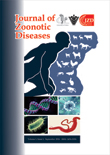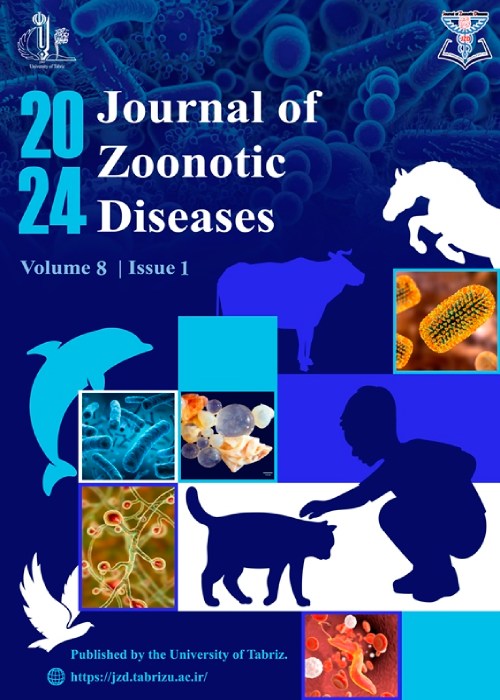فهرست مطالب

Journal of Zoonotic Diseases
Volume:2 Issue: 1, Spring 2017
- تاریخ انتشار: 1396/04/10
- تعداد عناوین: 7
-
-
Pages 1-8Lyme Borreliosis is a vector-transmitted zoonotic disease caused by the spirochetes from the Borrelia burgdorferi sensu lato complex. Dogs are the most susceptible domestic animals and serve as an appropriate animal model for detection of the endemic areas for Lyme borreliosis. The aim of the present study was to evaluate the occurrence and seroprevalence of B. burgdorferi infection among companion dogs population in Fars province, South of Iran, from December 2014 to September 2015. Blood samples were collected from 181 asymptomatic dogs, mostly referred to Veterinary Hospital of Shiraz University for regular vaccination. The antibody detection against B. burgdorferi was made by indirect Enzyme-linked Immunosorbent Assay (ELISA), employing B. burgdorferi VlsE antigen. A logistic regression model was developed to analyze multiple risk factors associated with seropositivity. Of 181 serum samples, 2 (1.1%) showed antibodies against B. burgdorferi, one was a 3-month old male watching dog with mix breed, and the other was a 2.5 year old female great din. Since no vaccination program was running in the studied population, positive samples were considered as naturally infected. The results of this study revealed the presence of B. burgdorferi infection among the companion dogs population in Fars province. In areas like Iran, where human cases of B. burgdorferi are not common or remain unreported, the public health implications of Lyme borreliosis seroprevalence in dogs are quite significant.Keywords: Lyme Borreliosis, Borrelia burgdorferi, Dogs, Fars
-
Pages 9-13The recent study was performed to investigate the effects of Antibiofin® (including mostly Thymus vulgaris) in drinking water on intestinal bacterial population in broiler chickens. A total of 120 one day-old broiler chickens were purchased and divided into three equal groups. Each group divided into four subgroup of 10 chicks. Chickens of groups A and B received 0.1% and 0.2% of Antibiofin®, respectively in drinking water from one week before vaccination till two weeks after vaccination. Chickens of group C did not receive Antibiofin®. All groups were subcutaneously vaccinated with AI-ND killed vaccine (subtype H9N2) at neck back site at nine days old. The results of this study showed that the consumption of antibiofin® at 0.1% and 0.2% concentrations reduced colony forming units of Escherichia coli in group A and B compared to control group, though it was not statistically significant. The colony forming units of Escherichia coli in digesta of ileo-cecum in group A and B on Mac Conkey agar, nutrient agar and Eosin methylene blue agar showed a lower number compared to control group. However, there was no significant difference between all groups in E. coli counts.Keywords: Antibiofin®, thyme extract, E. coli, intestine, broiler chickens
-
Pages 14-18Toxocariasis is a zoonotic disease caused by larvae of Toxocara cati and Toxocara canis. Human can be infected by ingestion of eggs of these parasites resulting in Visceral Larval Migrant Syndrome (VLMS). Human infection is occurring by the eggs of helminthes shed in faces of infected animals through the soil of public parks. In the present study, 540 soil samples were taken from 60 public parks in Tabriz (Northwest of Iran). Two hundred seventy samples were taken from 30 parks during warm seasons and 270 samples were taken from another 30 parks during the cold seasons of the year. Samples were tested by the Claytonlane method. From a total of 60 examined parks, 46 parks (76.66%) were contaminated with Toxocara spp. eggs and among 540 soil samples, 186 (34.44%) cases were contaminated with Toxocara spp. eggs. The level of contamination during cold the seasons were significantly higher than the warm seasons (PKeywords: Toxocara, Soil contamination, Park, Tabriz
-
Pages 19-29Animal bites are serious threats to human health due to their subsequent fatal infections such as rabies. The increasing rate of occurrences, the expanding number of animal bites and the distribution of rabies in many provinces of the country is alarming, necessitating further attention to control the disease and performing research on its different aspects. All records of animal bites referred to the clinic during 2010 to 2012 were included in this study. The obtained data were analyzed by descriptive statistics and Chi-square test. Of 1875 registered cases, 65% were men and 35% were women. The mean age of the patients was 33.18 ± 17.15 years in both genders. There was no death record due to rabies. Most of patients (97%) lived in urban areas. The highest number of bites was occurred at the age of 20‑29 years (33%) and the highest frequency of bites happened in spring (29%). There was a significant (PKeywords: Animal bite, Rabies, Shemiranat
-
Pages 30-34Bacteria have an important role in human and animal infections and bacterial resistance to antibiotics is a major problem following repetitive antibiotic therapy. Garlic has an antimicrobial activity. The aim of this study was to evaluate in vitro antibacterial effects of Azerbaijan garlic against some bacteria. Fifty clinical isolates and five control strains of bacteria included Escherichia coli, Pseudomonas aeruginosa, Klebsiella pneumonia, Staphylococcus epidermidis and Staphylococcus aureus were selected for the study. The MIC and MBC of garlic on bacteria were determined by microdilution assay. The garlic extract showed diverse activity against the bacteria.The MIC and MBC of garlic on gram-positive bacteriawere generally lower than gram-negative bacteria. This study confirms the antimicrobial potential of garlic, and garlic may be appropriate plant for treatment and prevent of infections.Keywords: Antimicrobial effect, Bacteria, Garlic
-
Pages 35-42Rabies is a fatal zoonotic disease with an approximately global distribution and wide host range. Rabies is caused by a Lyssavirus (Rhabdoviridae) that infects the nervous system and salivary glands. In this study, an occurrence of rabies in a horse in Iran is reported. In the spring of 2014 a Kurd stallion with severe abnormal behavior was examined in the suburb of Tabriz. The history was taken and the clinical signs that were obvious consisted of: changes in behaviors such as severe aggressive mood and anxiety, ataxia, circling, severe drooling and salivation, muscle tremors, photophobia, and abnormal biting; fusion mode and hypersensitivity were also seen. Body temperature was 39 oC. To confirm the diagnosis of disease, brain sample was taken by the special rabies sampling device and sent to the rabies laboratory. Because rabies is suspected, to identify the rabies virus the sample was examined using Fluorescence Antibody Test (FAT) in which the observation of the oval apple-green Negri-bodies is diagnostic of the disease. Due to the aggressive behavior and the severity of furious type of the disease and regarding to biting and even killing some sheep by the horse, the stallion was fasten by chains and finally euthanized with presumptive diagnosis of rabies. At the end the case was reported to the provincial Veterinary Organization office. Although the incidence of rabies is low (about %5) in horses and it is relatively uncommon disease in this species, the potential for human exposure highlights the importance of the disease to be investigated in horses.Keywords: Horse, Rabies, Fluorescence Antibody Test (FAT), Tabriz
-
Pages 43-47Dioctophyma renale (giant kidney worm), is an uncommon parasitic roundworm that may affect both humans and other mammals. This study reports a case of parasitism by the Dioctophyma renale in the peritoneal cavity with both sexes of worms in a stray dog from East Azerbaijan, Iran. A male adult stray dog was taken to the Department of Animal Pathology, Faculty of Veterinary Medicine, University of Tabriz, Tabriz, Iran. Clinical signs were suggestive of a case of peritonitis. During necropsy, two brownish-red nematodes, were found in the abdominal cavity and was identified as male and female adult D. renale. Adult male worm measured up to 35 cm x 6-7 mm wide, and female was up to 36 cm x 7-9 mm wide. This study reports the first confirmed case of dioctophymatosis with both sexes of worms in the dog. The parasites aberrant location in the peritoneal cavity suggests that the dog is not a suitable host.Keywords: Dioctophyma renale, peritoneal cavity, stray dog, East Azerbaijan, Iran


